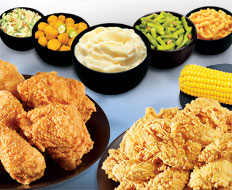Golden Chick, with stores in Texas and Oklahoma, maintains a philosophy of controlled, concentric, regional growth—except for one very big exception.
“We should see our first unit in China open some time next year,” says Golden Chick president Mark Parmerlee.
Golden Chick minority partner Allen Tharp, a restaurant industry veteran and owner of the Lion and Rose chain of British restaurants in Texas, secured the rights to open Golden Chick restaurants in 10 Asian countries.
“Allen has a very capable team with chicken experience in Asia,” Parmerlee says. “It’s more of a licensing fee than a true franchising situation.”
So while Tharp handles Golden Chick development in Asia, Parmerlee continues the work he and his team began in 1989 when they took over the then-struggling chicken chain that started in a small central Texas town in 1967.
“It was started as Golden Fried Chicken by Howard Walker, who worked for a national chicken franchisor and thought he could do it better,” Parmerlee says. “But like Ray Kroc, he got started later in life and when someone came along and offered to buy, he accepted.”
The new ownership group took over in the early ’80s, right before the Texas economy hit the skids. The chain ended up in bankruptcy. And Parmerlee and his partners bought Golden Fried Chicken, which consisted of 63 units, in 1989.
“We saw a good product; high-quality food with a lot of attention to fresh preparation and a lot of small operators who were very involved in their units and had a great customer base in small towns,” Parmerlee says.
That’s not to say there wasn’t work to be done.
“Having met the franchisees, we concluded that these were hard-working people who knew their customers, knew their towns, and knew their business,” he says. “So we took the approach of not wanting to upset the apple cart. We asked ourselves, ‘What’s the first thing we can do to help these people make money?’ And we realized our predecessors could have done a better job in purchasing.”
Parmerlee says the former owners did not have a national contract with a beverage supplier, nor did they have a fixed-price contract with a chicken supplier. There were also complaints about the distributor’s prices being high because there was no favorable pricing for group buying.
“By changing these things, we saved the franchisees about 5 percent in food costs,” Parmerlee says. “We became instantly popular with them.”
Parmerlee says restaurant logos and signage were also inconsistent, and that the name Golden Fried Chicken was not federally registered. The name was officially changed to Golden Chick in 1993.
Golden Chick
President: Mark Parmerlee
HQ: Dallas
Year Started: 1967
Annual Sales: $60 million
Total Units: 90
Franchise units: 86
“We did research and found there was brand equity with the word golden, and we took the word fried out because we were starting to add roasted chicken,” he says.
Once the name issue was settled, the chain underwent its first-ever chain-directed remodel. It was also determined through extensive market research that the chain’s most popular offering was not its fried chicken pieces, but rather its Golden Tenders.
“Golden was really the first to take the chicken tenderloin, marinate it, and bread it in-house,” Parmerlee says.
The Tenders, available in sandwiches or in orders from two to 30, are still the most popular menu item at Golden Chick. While market research pinpointed the popularity of tenders, changes were made to the menu as a result of other research. The chain, for example, switched from biscuits to yeast rolls. Menu offerings were broadened with the help of a local chef who developed a roasted chicken and a gourmet chicken salad. The salad, made with white meat, grapes, and walnuts, is one that Parmerlee says “caterers buy and try to pass off as their own.”
Another menu change was the addition of catfish.
“In Texas and Oklahoma, catfish is very popular,” Parmerlee says. “Not all small towns have quick-service seafood, so it made sense.”
He says Golden Chick buys only premium catfish and hand breads it with a proprietary breading recipe.
“It gets rave reviews,” he says. “In fact, we sell more catfish than roast chicken.”
Green beans were added to make the assortment of sides healthier, and the chain is testing salads as well.
The number of customers at Golden Chick stores is split evenly between lunch and dinner. An average ticket at Golden Chick is about $7 at lunchtime, when there are more single diners. Bulk buying brings the dinner average ticket up to about $14.
“About 70 percent of Golden Chick business is drive thru,” Parmerlee says. “People buying for the whole family.”
Parmerlee says the lure of fried chicken and the challenge of making it at home should drive continued growth for Golden Chick at a controlled rate for several years in its home region of Texas and Oklahoma.
“At some point we will step out and expand our boundaries,” he says. “But we’d probably want to do it with two or three stores in an area, almost like a hub.”











